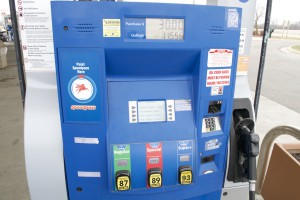
Gas prices are leveling off after hitting a two-year high in the wake of Hurricane Harvey. (Photo credit: Brendan Strong)
Gasoline prices appear to be leveling across the U.S. off despite the disruptions created by two major hurricanes that have battered the United States causing some local shortages, AAA reported in its weekly analysis of fuel prices around the country.
AAA said for the first time in more than two weeks, the national gas price average despite Hurricane Irma’s landfall in Florida with gasoline prices holding steady at $2.67. The national gas price average is just three cents more expensive on the week, which saw a massive evacuation from parts of Florida as the storm approached.
With a seven-cent increase, Florida, Indiana and Georgia were among the top 10 states who saw the largest gas price increases on the week, while gas prices dropped by one to six cents per gallon in Ohio, Kansas, Kentucky, Missouri, Delaware and Oklahoma, AAA reported.
In addition, of last week, some Florida and other Southeast states saw consumers flock to gas stations to fill-up on fuel, causing some stations to have gas outages ahead of the storm.
(Gas prices hit two-year high in wake of Hurricane Harvey. Click Here for the story.)
Overall $2.67, the national gas price average is 29 cents more expensive on the week. Motorists in 26 states are paying 25 to 44 cents more for a gallon of unleaded compared to two weeks ago before the storms hit the U.S. mainland.

Gas prices rose after Harvey, but refineries are beginning to come back online. (Photo credit: Brendan Strong)
“Irma was one of the most powerful Atlantic hurricanes in history,” said Jeanette Casselano, AAA spokesperson.
Early reports indicate that Irma has left more than 6 million residences and businesses, including gas stations and car dealerships without power, while water and debris cover roadways. Florida Power & Light has 17,000 personnel from more than 30 states on standby to aid restoration efforts.
Once power is restored and roads cleared, gasoline will be able to be delivered to stations in the impacted region, similar to what the Gulf Coast experienced post-Harvey, Casselano noted.
“There is not a gasoline shortage in the U.S., but instead localized challenges — power outages, impassable roads, debris — in Florida keeping gasoline supplies from where they are needed most,” Casselano said.
“Total U.S. gasoline stocks sit above the five-year average. Since much of Florida’s gasoline delivery occurs via barge, all eyes will remain on port conditions as the storm passes,” she said.
(Click Here for details about the national average fuel economy dropping.)
Moreover, the price of crude oil also has remained stable at around $47 per barrel even though the storms have curtailed some drilling operations in the Gulf of Mexico.
Currently, all Florida ports are closed while some in North and South Carolina are open with restrictions. To alleviate local supply disruptions, the U.S. Department of Homeland Security approved a Jones Act waiver for areas affected by the storms.
The seven-day waiver will allow foreign flag vessels to bring in fuel to help with outages amid the response and recovery efforts.
As residents of Florida begin to return home, residents of Texas and parts of Louisiana continue to recover from the devastation left behind by Hurricane Harvey.
At least five refineries in the Gulf Coast, which accounts for roughly 8% of U.S. refining capacity are operating at reduced rates. Six refineries accounting for another 12% are in the process of restarting, according to the U.S. Department of Energy.
But ive refineries remain shutdown, accounting for 6% of U.S. refining capacity. The restarting process can take several days or weeks, depending on damage. The Colonial Pipeline continues to experience a delivery delay of up to a week to Mid-Atlantic states, Department of Energy said.
(To see more about the White House releasing some of the strategic reserves, Click Here.)
Casselano added as the Gulf Coast refineries slowly come back online, states along the East Coast can expect will expect to see som volatility in prices as supply levels have dropped in the wake of Harvey.

In some areas this was pre profiting from pain, and in others pure greed as petrol prices in my area rose significantly two ~ three weeks BEFORE Harvey, let alone Irma and Jose.